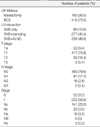Abstract
Purpose
Sentinel lymph node biopsy (SLNB) has been developed to accurately assess the axillary lymph node status accurately without having to remove most of the axillary contents in node negative early breast cancer patients. The aims of this study were to evaluate the accuracy, the false negative rate and the advantage of additional axillary sampling for SLNB with using radioisotope.
Methods
Between December 2003 and June 2005, we carried out SLNB for 574 breast cancer patients who were diagnosed and had operation at Asan Medical Center. For detection of the sentinel lymph node (SLN), radioisotope was injected into the periareolar area on the operating day, breast scintigraphy was performed and finally the biopsy was done using a gamma-detection probe in the operating room. If the SLN turned out to be positive for metastatic malignancy according to the frozen section histology, then additional axillary lymph nodes (LN) dissection was performed. But, if it was free of metastasis, then only axillary node sampling (n≤5) or no further treatment was done.
Results
The mean number of resected SLNs was 2.67±0.98 (1-7) and the mean number of total LN was 8.5±5.0 (1-38). The SLN was detected 82.8% of the time on lymphoscintigraphy and 98.4% of the time with the gamma probe. Axillary metastasis was founded in 118 cases (20.9%). The accuracy was 98.2%, and the false negative rate was 7.89%. For the SLN positive cases, there were 73/78 cases (93.6%) of 1st SLN metastasis, there were 75/78 cases (93.6%) of 1st and 2nd SLN metastasis, and 75/78 (93.6%) of 1st to 3rd SLN metastasis. The false negative rate of the alternative frozen section was 40% and that of the full frozen section was 24.1%. The difference was statistically significant.
Conclusion
SLNB using 99mTc-antimony trisulfide colloid (0.5 mCi) showed a high detection rate and a low false negative rate. The false negative rate was decreased by using full section H&E staining and at least 3 SLNs showed the exact LN status. Even if the SLN was free of metastasis, additional sampling may decrease the false negative rate.
Figures and Tables
References
1. Fisher ER, Sass R, Fisher B. Pathologic findings from the national surgical adjuvant project for breast cancer (protocol No.4). X. Discriminants for tenth year treatment failure. Cancer. 1984. 53:712–723.

2. Carter CL, Allen C, Henson DE. Relation of tumor size, lymph node status, and survival in 24.740 breast cancer cases. Cancer. 1989. 63:181–187.

3. Weaver DL. Sentinel lymph nodes and breast carcinoma: which micrometastases are clinically significant? Am J Surg Pathol. 2003. 27:842–845.
4. Giuliano AE, Kirgan DM, Guenther JM, Morton DL. Lymphatic mapping and sentinel lymphadenectomy for breast cancer. Ann Surg. 1994. 220:391–398.

5. Pizzocaro C, Rossini PL, Terzi A, Farfaglia R, Lazzari L, Simoncini E, et al. Sentinel node biopsy in breast cancer: the experience of brescia Civic Hospital. Tumori. 2000. 86:309–311.

6. Nieweg OE, Estourgie SH. What is a sentinel node and what is a false negative sentinel node? Ann Surg Oncol. 2004. 11:169–173.
7. Hoar FJ, Stonelake PS. A prospective study of the value of axillary node sampling in addition to sentinel lymph node biopsy in patients with breast cancer. Eur J Surg Oncol. 2003. 29:526–531.

8. Morton DL, Wen DR, Wong JH, Economous JS, Cagle LA, Storm FK, et al. Technical details of intra operative lymphatic mapping for early stage melanoma. Arch Surg. 1992. 127:392–399.

10. Krag DN, Weaver DL, Alex JC, Fairbank JT. Surgical resection and radiolocalization of the sentinel lymph node in breast cancer using a gamma probe. Surg Oncol. 1993. 2:335–340.

11. Fisher B, Wolmark N, Bauer M, Redmond C, Gebhardt M. The accuracy of clinical nodal staging and of limited axillary dissection as a determinant of histologic nodal status in carcinoma of the breast. Surg Gynedol Ostet. 1981. 152:765–772.
12. Cody HS 3rd, Fey J, Akhurst T, Fazzari M, Mazumdar M, Yeung H, et al. Complementarity of blue dye and isotope in sentinel node localization for breast cancer: univariate and multivariate analysis of 966 procedures. Ann Surg Oncol. 2001. 8:13–19.

13. Noguchi M, Motomura K, Imoto S, Miyquchi M, Sato K, Iwata H, et al. A multicenter validation study of sentinel lymph node biopsy by the Japanese breast cancer society. Breast Cancer Res Treat. 2000. 63:31–40.

14. Kim SW, Han WS, Pak IA, Chung JK, Yeo JS, Moon WK, et al. Prospective study of 162 sentinel lymph node biopsies in breast cancer: usefulness of ultrasonography in patients selection. J Korean Breast Caner. 2003. 6:103–108.

15. Wilhelm AJ, Mijnhout GS, Franssen JF. Radiopharmaceuticals in sentinel lymph node detection an overview. Eur J Nucl Med. 1999. 26:36–42.
17. Roumen RM, Geuskens LM, Valkenburg JG. In search of the true sentinel node by different injection techniques in breast cancer patients. Eur J Surg Oncol. 1999. 25:347–351.

18. Veronesi U, Paganelli G, Viale G, Galimnerti V, Luini A, Zurrida S, et al. Sentinel lymph node biopsy and axillary dissection in breast cancer: results in a large series. J Natl Cancer Inst. 1999. 91:368–373.

19. Hill AD, Tran KN, Akhurst T, Yeung H, Yeh SD, Rosen PP, et al. Lessons learned from 500 cases of lymphatic mapping for breast cancer. Ann Surg Oncol. 1999. 229:528–535.





 PDF
PDF ePub
ePub Citation
Citation Print
Print








 XML Download
XML Download